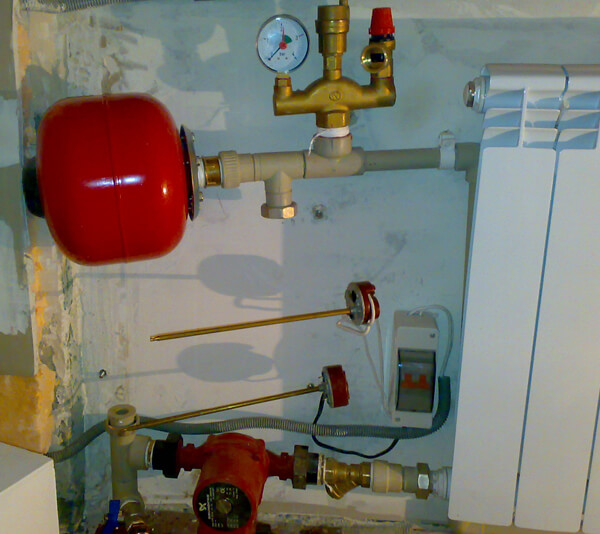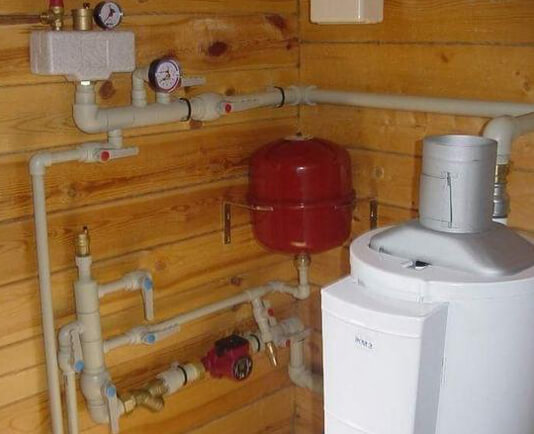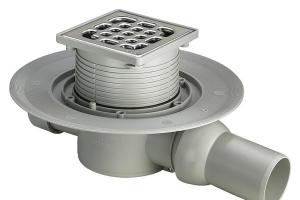Expansion tank for heating - a must
Since in the heating circuit and pipeline (having elasticity tending to zero), the coolant has a fixed mass, if the temperature of the liquid changes, the pressure in the system will certainly change. The fact is that due to such a physical phenomenon as thermal expansion, water or any other type of heat carrier increases its volume when heated. In the event that the load exceeds the tensile strength of the radiator or pipeline, big troubles cannot be avoided.
The solution to this problem is to connect a tank with an easily compressible substance, or rather with air. When there is an expansion tank for heating, such as in the photo, with an increase in the volume of liquid, the pressure increases slightly.
So that the oxygen in the air chamber of the device, dissolving in water, does not cause corrosion of some elements of the system (closed type), it is separated from the liquid by a rubber membrane.
With such drops, the liquid pressure is in no way able to squeeze air out of the upper part of the heating structure. Hence the decision arises - to install a container that collects air in the place where it accumulates and bleed it during the system startup. All air plugs in pipes and radiators are forced up and sent to the expansion tank.
Check out the video on the principle of operation of the expansion tank for heating:
The reason for a possible accident is that water, which has no compressibility, changes volume when heated and still remains almost unchanged. Hence, the probability that a water hammer can occur sharply increases, since there are no elastic interactions in a liquid medium.
The solution to this problem is to connect a tank with an easily compressible substance, or rather with air. When there is an expansion tank for heating, such as in the photo, with an increase in the volume of liquid, the pressure increases slightly.
So that the oxygen in the air chamber of the device, dissolving in water, does not cause corrosion of some elements of the system (closed type), it is separated from the liquid by a rubber membrane.
![]()
- in open-type heating structures in the presence of contact with atmospheric air;
- in centralized heating systems with top discharge. In this case, an expansion tank for heating is installed in the attic and connected to a part of the pipeline of the heating structure of the building that supplies the heat carrier.
In both cases, the installation of these devices is necessary to rid the heating system of air pockets. Between two lines of central heating, the difference is about 2 meters, and in private houses with natural circulation of the coolant, even less.
With such drops, the liquid pressure is in no way able to squeeze air out of the upper part of the heating structure. Hence the decision arises - to install a container that collects air in the place where it accumulates and bleed it during the system startup. All air plugs in pipes and radiators are forced up and sent to the expansion tank.
If an open system is used, no action is required. The air will immediately connect to the atmosphere, unlike the closed version, when it is necessary for the owner to open the air valve (read also: "").

Features of installing expansion tanks
open system. If it is planned to install, then it should be taken into account that such a design is a complex shape of a large vessel in which convection flows are observed.Installation of heating equipment and installation of pipelines in this case should solve several problems:
- ensure the rapid rise of the water heated by the boiler to the highest point of the system and, if necessary, drain it by gravity through the heat supply design devices;
- create an unimpeded movement of air bubbles to where they rush in any vessel containing any liquid, or rather upwards.
- it is necessary to install an expansion tank for heating in open systems only at its highest point. Most often this is the top of the accelerating manifold for a single-pipe design. In the houses of the upper bottling (these are usually buildings whose age is more than a dozen years), their place of installation is the attic (read: "");
- expansion tank for open systems does not require shut-off valves, a rubber membrane and a cover. The device of the expansion tank of the heating system is a water tank, into which, if desired, you can add a bucket of liquid instead of the one that has evaporated.
The cost of such a product corresponds to the price of a pair of welding electrodes and a square-shaped desktop sheet having a thickness of 3-4 millimeters.

Among the features of the arrangement of closed systems, a number of points should be noted:
- It is necessary to mount the expansion tank of the heating structure in the place where the water flow is as close as possible to the laminar type, in which there is a minimum of turbulence. The most optimal solution is to install the device on a straight section of the spill, but up to the location of the circulation pump. What is interesting: the height of the attachment of the device relative to the boiler or flooring does not matter, since the principle of operation of the expansion tank is based on the need to compensate for thermal expansion and dampen water hammer, and air can be bled off without problems through air valves.
- In the configuration of manufacturers, devices are often equipped with a safety valve to relieve excess pressure. But it is better for the buyer to first make sure that it is available. In case of absence, it is better to purchase and place it next to the tank.
- Heating boilers that use electricity or gas in their work, equipped with electronic thermostats, are very often sold with a built-in expansion tank and a circulation pump. Going for equipment, you need to make sure that they are required for the functioning of the heating system.
- Membrane expansion tanks have a fundamental difference from the devices used in, and this is their location in space. The coolant must enter from above and this feature allows you to completely remove air from the chamber intended for the liquid.
- Expansion tanks for water heating systems must have a minimum volume equal to 1/10 of the total amount of coolant in the system. A larger parameter is allowed, but a smaller one is dangerous. An approximate version of calculating the volume of water, based on the power of the boiler, is as follows - 15 liters of coolant are required per kilowatt.
- Mounted next to the device and the make-up valve (it connects the heating to the plumbing), a pressure gauge can help a lot. Such an unpleasant situation as a stuck spool of a safety valve often occurs (read also: "").
- When the valve relieves pressure in the heating expansion tank quite often, this means that the required volume of the device is calculated incorrectly. But it should not be changed to a new product. You need to purchase another safety valve and connect in parallel.
- Water used in heating systems has a low coefficient of thermal expansion. If you use a non-freezing coolant (most often it is ethylene glycol), you will need a larger expansion tank or the installation of another, additional device. See also: "".
An expansion tank mounted in accordance with all the rules in closed systems looks like this: the coolant is connected to it from above, it is equipped with a safety valve and a pressure gauge. See also: "".
Check out the video on the principle of operation of the expansion tank for heating:



